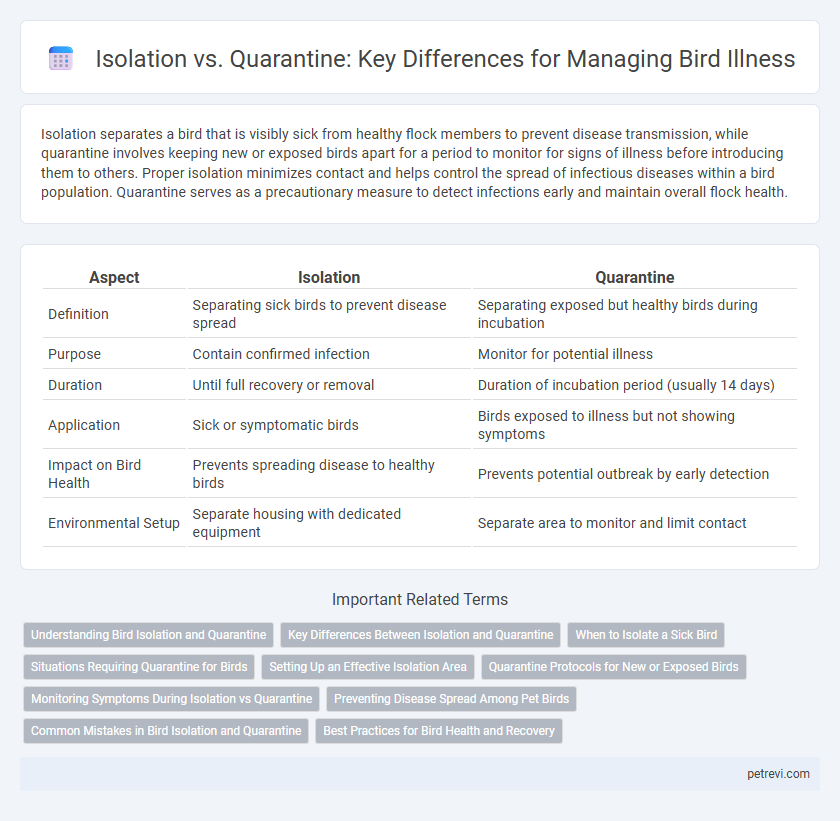Isolation separates a bird that is visibly sick from healthy flock members to prevent disease transmission, while quarantine involves keeping new or exposed birds apart for a period to monitor for signs of illness before introducing them to others. Proper isolation minimizes contact and helps control the spread of infectious diseases within a bird population. Quarantine serves as a precautionary measure to detect infections early and maintain overall flock health.
Table of Comparison
| Aspect | Isolation | Quarantine |
|---|---|---|
| Definition | Separating sick birds to prevent disease spread | Separating exposed but healthy birds during incubation |
| Purpose | Contain confirmed infection | Monitor for potential illness |
| Duration | Until full recovery or removal | Duration of incubation period (usually 14 days) |
| Application | Sick or symptomatic birds | Birds exposed to illness but not showing symptoms |
| Impact on Bird Health | Prevents spreading disease to healthy birds | Prevents potential outbreak by early detection |
| Environmental Setup | Separate housing with dedicated equipment | Separate area to monitor and limit contact |
Understanding Bird Isolation and Quarantine
Isolation and quarantine are critical measures in managing bird illnesses, with isolation referring to separating sick birds from healthy ones to prevent disease spread, while quarantine involves restricting movement of apparently healthy birds exposed to illness. Understanding bird isolation requires identifying symptoms early and providing a separate environment with proper ventilation to reduce contagion risk. Effective quarantine includes monitoring bird health for incubation periods, minimizing stress, and preventing contact with wild or other domestic birds to control potential outbreaks.
Key Differences Between Isolation and Quarantine
Isolation separates sick birds showing symptoms of illness to prevent disease spread, while quarantine restricts movement of healthy birds exposed to a contagious disease during incubation. Isolation requires individual housing with strict hygiene protocols to contain pathogens, whereas quarantine involves monitoring exposed birds for signs before integrating them back into the flock. Understanding these distinctions ensures effective disease control and safeguards overall avian health.
When to Isolate a Sick Bird
Isolate a sick bird immediately upon noticing symptoms such as lethargy, loss of appetite, or abnormal droppings to prevent the spread of contagious diseases like Psittacosis or Avian Influenza. Isolation should occur in a separate, well-ventilated space away from other birds to minimize cross-contamination. Quarantine is recommended for new or exposed birds before integration, but isolation is critical once illness is confirmed.
Situations Requiring Quarantine for Birds
Situations requiring quarantine for birds include introduction of new birds into an existing aviary, suspected exposure to infectious diseases like avian flu or psittacosis, and recovery after treatment for contagious illnesses. Quarantine helps prevent disease transmission by isolating birds with unknown health status for a minimum of 30 days, allowing monitoring for symptoms. Effective quarantine protocols involve separate housing, dedicated equipment, and strict hygiene to ensure containment of pathogens and protect flock health.
Setting Up an Effective Isolation Area
Setting up an effective isolation area for bird illness requires a well-ventilated space separate from healthy birds to prevent disease transmission. Use easily disinfected materials and provide dedicated feeding and watering equipment to minimize cross-contamination. Regular monitoring and strict hygiene protocols are essential to control the spread of infectious agents within the facility.
Quarantine Protocols for New or Exposed Birds
Quarantine protocols for new or exposed birds are essential to prevent the spread of avian diseases such as Psittacosis and Avian Influenza. New birds should be isolated in a separate, well-ventilated area for a minimum of 30 days while closely monitoring for symptoms like respiratory distress or lethargy. Implementing strict hygiene practices, including regular cage cleaning and disposable gloves, reduces the risk of transmitting pathogens to existing bird populations.
Monitoring Symptoms During Isolation vs Quarantine
During isolation, birds showing signs of illness require continuous monitoring to track symptoms such as lethargy, respiratory distress, and abnormal droppings, ensuring timely intervention. Quarantine involves observing new or exposed birds for a defined period, typically 30 days, to detect early signs of infectious diseases before introducing them to the main flock. Accurate symptom tracking during both isolation and quarantine reduces the risk of disease spread and supports effective treatment strategies.
Preventing Disease Spread Among Pet Birds
Isolating sick pet birds immediately upon signs of illness prevents direct contact and reduces the risk of disease transmission. Quarantine procedures for new or recently exposed birds involve at least 30 days of monitoring separate from the main flock to detect latent infections. Maintaining strict hygiene and separate equipment during isolation and quarantine periods is essential to control pathogenic spread and protect the health of all pet birds.
Common Mistakes in Bird Isolation and Quarantine
Common mistakes in bird isolation and quarantine include inadequate separation between new and existing birds, leading to cross-contamination and disease spread. Failing to maintain strict sanitary practices and inconsistent monitoring of symptoms can compromise the effectiveness of quarantine protocols. Proper isolation requires dedicated equipment, controlled airflow, and a minimum 30-day observation period to detect and prevent avian illnesses like psittacosis and avian influenza.
Best Practices for Bird Health and Recovery
Isolation involves separating a sick bird from healthy ones to prevent disease transmission, while quarantine is the preventive measure of keeping new or exposed birds separate before introducing them to the flock. Best practices for bird health and recovery include maintaining a clean, stress-free environment, providing nutritious food, fresh water, and monitoring for signs of illness regularly. Veterinarian consultation is crucial for accurate diagnosis and treatment, ensuring proper medication and care tailored to the bird's specific condition.
Isolation vs Quarantine for Bird illness Infographic

 petrevi.com
petrevi.com